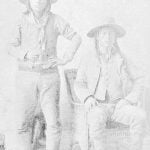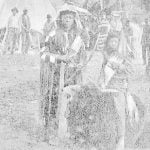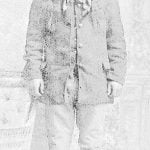The Warm Springs Indians came from near The Dalles, Oregon, in 1858-1859; the Wascos, from The Dalles, or near it, in 1858-1859; the Teninos, from near The Dalles in 1858-1859; the John Days, about 30 years ago, from or near John Days River, 40 miles east; of The Dalles. The Piutes (Pah Utes) were formerly located on the Malheur reservation, Oregon, but after the Bannock War of 1878-1879 they were taken to Port Vancouver or the Simcoe agency, Yakama reservation, most part to the latter place; those front Vancouver came here in the fall of 1879; those front Yakama came here mostly in 1884-1885.
The section of country embraced by the Warm Springs reservation, and southeast of it toward Harney Lake and the Malheur country, and even beyond, was once claimed by the people to whom the Piutes (or Snakes) belong. After the Bannock war the Malheur reservation was abandoned and. the Piutes were scattered.
The Warm Springs, Wasco, Tenino, and John Day tribes have resided along the Columbia, River below, at, or above The Dalles, from time immemorial. They were parties to the treaty of June 25, 1855, and were named “The Confederated Tribes and Bands in Middle Oregon”.
In the early days of this reservation there were several bands of what are now called Warm Springs Indians, as “The Tyghs”, “The Deschutes”, taking their names from the locality in which they then lived.
The Tenino tribe took its tame front a fishing point on the Columbia River some miles above The Dillies, called “Tenino”.
Among the Wasco tribe are some that were called “Dog Rivers”, a stream above the cascades of the Columbia and running into that river. It was called by the white people ”Dog river”, and from whence some of these Indians came to this reservation.-James C. Luckey, United States Indian agent.
Warm Springs Reservation
The Warm Springs reservation is situated partly in Wasco and partly in Crook County, Oregon, its western boundary running along the summit of the Cascade Range of mountains. It derives its name from the hot springs, which occur on one of the streams flowing through the reservation. The reservation consists of 464,000 acres of poor land.
Of the 464,000 acres embraced in the reservation, bounded on the north by the Mutton mountains, on the east by the Des Chutes river, on the south by the Metolias River, and on the west by the Cascade mountains, there are not 5,000 acres fit for cultivation. The thin soil of the plateaus has been denuded by the winter rains and melting snows and deposited in the Pacific ocean, leaving bare the basaltic boulders resting on the lava flow, front which they have some time been detached. Even the bunches of grass once scattered here and there are no longer to be seen.
The Indians on this reservation number 924, the majority of whom belong to the Wasco and Walla Walla tribes. About 80 Snake Indians have been placed here, who live by themselves in one portion of the reserve, having little or no intercourse with the other Indians, whom they regard as their natural enemies. The Walla Walla tribes live in the vicinity of Sinemasho, occupying wigwams, which are grouped together in camps or villages. They are classified on the census returns as members of the Warm Springs tribe, though strictly speaking there is no such tribe. Of 430, the whole number of this tribe, 336 can not speak. English; 49 are engaged in farming; the number of children of school age is 88, and the average attendance at Sinemasho school is 40. A large number of these Indians adhere to the teachings of Smohalla, and it is against their creed to pattern after the whites in any particular. They still cling to all their old customs and habits, have the same superstitions, and respect and honor the medicine man when he is successful and murder him when he fails. A Bible reader of the United Presbyterian church reports that she once visited a Walla Walla camp and found 2 very old women tied to a stake, and on inquiring why they were subjected to this indignity she was informed that they were staked out to die. On a second visit a short time afterward she learned that both were dead. On one occasion she found a camp deserted by all save 2 old blind women, who occupied a filthy wigwam, and whose only food was dried salmon. A rope had been stretched from the wigwam to the water, fastened at both ends, so that by feeling their way along it they could reach the water and then return to their wigwam.
Many of the Indians of this tribe have been allotted land in severalty.
The Wasco tribes, who arc located on Tenino and Chitike creeks, near the agency, are far in advance of the Walla Wallas in civilization. Owing to the missionaries who have been among them, fully one-third of them are communicants, of the United Presbyterian church. Most of the Wascos have frame or box houses, many of them well furnished. The Snake Indians located on this reservation, who are elsewhere so worthless, show commendable industry and frugality.
The Warm Springs agency is situated near the junction of Tenino and Chitike creeks, about 90 miles south of The Dalles, which is the nearest railroad station. Some of the agency buildings are new, and all are in good condition. The sawmill is located about 15 miles from the agency, near the foot of the Cascade Mountains, where there is an abundance of good timber. There are 2 schools, 1 at Sinemasho and the other at the agency, both under charge of competent instructors. The vegetable gardens at both schools were a complete failure in the census year. Of the children sent from this reservation to Chemawa school, near Salem, 30 per cent died shortly after returning home, all of them being affected with pulmonary troubles.
Some very fine specimens of chalcopyrite and sphalerite have been found not far distant from the wagon road near the Warm Springs River. Gold is known to exist on the reservation, but has never been mined. Indians have asked to be permitted to work a gold placer mine on the reservation, but have been refused, in. accordance with the rules and regulations prohibiting the opening of mines except for fuel.
The census at this reservation was very well taken and no difficulty experienced in obtaining statistics of the different tribes, as they dwell separately and apart from each other.
General Remarks And Recommendations
Warm Springs Indians
I would suggest that every effort be made to induce the Indians on the Warm Springs reservation to remove to some place where better land can be secured for them by the government, and that the reservation be abandoned and sold. If the consent of all the Indians to removal can not be obtained, those who will consent should be removed to other reservations, and the little good land there is at Warm Springs should be divided among those who remain. The balance should be thrown open to entry and the agency abandoned, for it is useless to attempt to do anything further with these Indians it’ they persist in clinging to their worthless land.
The Warm Springs Indians have little agricultural land, and therefore get few implements; the majority live in tepees, and therefore get no building hardware. About all they get are wagons, harness, and. axle grease, Many of them are in destitute circumstances.




